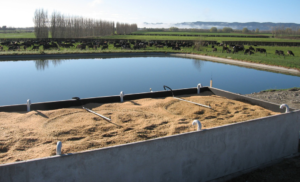BioFiltro Bida System

Technology Description
Biofiltration wastewater treatment system that uses physical and biological filtration, aerobic and anaerobic medias, and nitrification and denitrification processes to produce clean water and fertilizer. The system relies on earthworms and bacteria to break down contaminants on the surface. Water trickles down through sawdust and gravel layers, resulting in high quality effluent.
Technology Stage
Commercially available worldwide (39 food processors, 57 sanitary waste facilities, 12 slaughterhouses, 11 wineries, 10 dairies)
Technology Application(s)
Remove >90% of BOD and TSS on-site
Earthworms rapidly treat water and produce worm casings for fertilizer
Applicable in many climatic conditions
Modular, with facilities ranging in size between 100 gpd to 2 mgd
Technology Benefits:
- Builds drought resilience
- Produces recycled water that is able to replace flood irrigation systems with more efficient irrigation delivery systems, such as sprinkler or drip systems.1
- Removes nitrates from process water effluent, enabling beneficial reuse without risk of increasing salt concentrations in fields and groundwater, protecting potable resources.
- Produces secondary undisinfected quality effluent, which is irrigation-ready, and can be modified for tertiary disinfection for use in urban systems.
- Supports electric reliability:
- Reduces electric consumption (kWh) by 95% compared to traditional wastewater treatment methods. The passive aerobic process averages 0.0007 kWh/ gallon treated.2
- Reduces electric demand (kW)3 – 1-2 horsepower pumps, with [# of pumps per area]
- Reduces pumping hours – Pumps activate only when a facility discharges, and can coordinate with intermittent irrigation schedule. Typically only demands energy for 8 hours a day. Standard facilities operate 24 hours a day. Can be scheduled for off-peak hours.
- Reduces greenhouse gas emissions:
- Reducing electric use and electric demand reduce production and/or purchase of marginal electric resources, much of which is produced by natural gas.
- Earthworm tunneling increases aeration of filtration medium, encouraging aerobic processes to produce less methane.
- No sludge eliminates solids management and hauling, eliminating truck emissions
- Treats water right away in four hours, so there is a 90% reduction in methane from dairy wastewater
- Reduces ratepayer costs:
- Telemetry monitoring and annual maintenance are centralized, automating wastewater treatment and creating economies of scale for participating communities. These services reduce the need for dedicated operations and maintenance staff for small community wastewater systems, saving costs.
- Modularity of system reduces costs, extends life, and reduces need for expensive, long lead-time retrofits of large centralized wastewater treatment systems, which reduces costs of wastewater collection and treatment for all customer classes
- Reduction of biosolids transportation costs by up to 100%
- Reduces regulatory and environmental risks:
- Alleviating aged wastewater collection and treatment infrastructure reduces frequency of regulatory permit violations and inadvertent discharge of untreated and/or nondisinfected wastewater effluent to the environment, reducing risks to people, animals and plants
- Nitrification and denitrification reduce nitrate contamination of groundwater from reuse sites.
- BOD and TSS removal rates >90%
1 https://www.wateronline.com/doc/earthworms-star-latest-wastewater-filtration-tech-0001
2 http://biofiltro.com/en/
3 Document basis for est. electric demand (kW) savings
Current Status
 Technology has been successfully installed and benefits documented at 39 food processors, 57 sanitary waste facilities, 12 slaughterhouses, 11 wineries, 10 dairies facilities:
Technology has been successfully installed and benefits documented at 39 food processors, 57 sanitary waste facilities, 12 slaughterhouses, 11 wineries, 10 dairies facilities:
Interstate 5 Highway Interchange, Firebaugh, California (2016). The Interstate 5 Highway Interchange located in Fresno County (Exit 368) is home to a handful of fast food restaurants, gas stations and one hotel located in remote farm fields. After decades of using an old activated sludge system, the area was in need of an upgrade, so the property owners researched several options.
In 2015, I-5 Property Services Inc. opted to install a pilot BIDA® System in order to test the technology during the holiday season where usage of the interchange peaks due to increased road traffic over Thanksgiving and December holiday vacation. Shortly after the holidays, I-5 Property Services moved to install an 80,000 GPD BIDA® System in 2016.
- 80,000 gpd maximum daily flow design
- 3 million gallons treated
- 9 businesses served[1]
Mostos del Pacífico grape juice concentrate and winery, Curicó, Chile - processes more than 110,000,000 tons of grapes per year. The facility previously employed a hold and haul process by contracting waste haulers to transport their discharge to a local municipal plant. As production was limited by wastewater storage capacity and transport costs rose into the hundreds of thousands, Mostos looked for an economical and comprehensive wastewater treatment provider. Within 90 days of being awarded the bid, BioFiltro commissioned a fully operable 75,000 GPD facility that included the design, construction, and operation of screens, a chemical-free DAF, and the BIDA® System. The facility was recently expanded to filter approximately 100,000 GPD and handles 100% of the plant´s effluent which fluctuates in BOD throughout the production season.
All large organic solids captured in the screens and DAF are treated onsite in secondary vermicomposting bins, effectively making the facility a zero waste system.
- 90 days from signed contract to plant coming online
- 0 chemicals used in DAF system
- 0 waste hauler trucks currently in use
[1] http://biofiltro.com/en/clean-it/14/california-interstate-5-highway-interchange/


